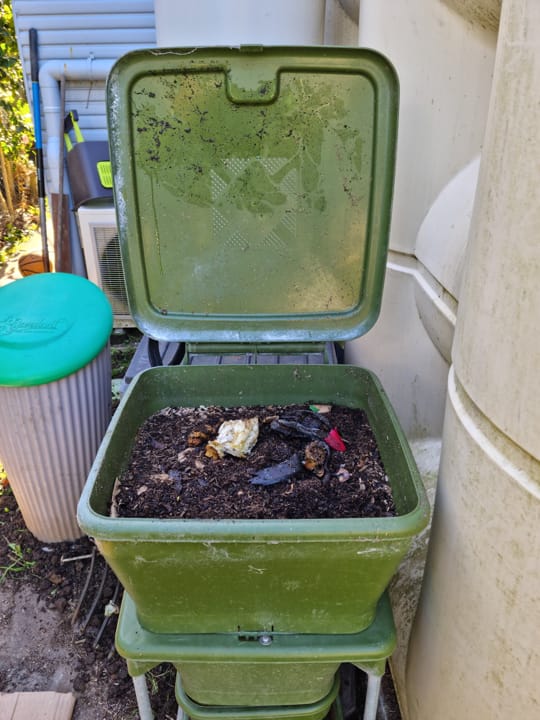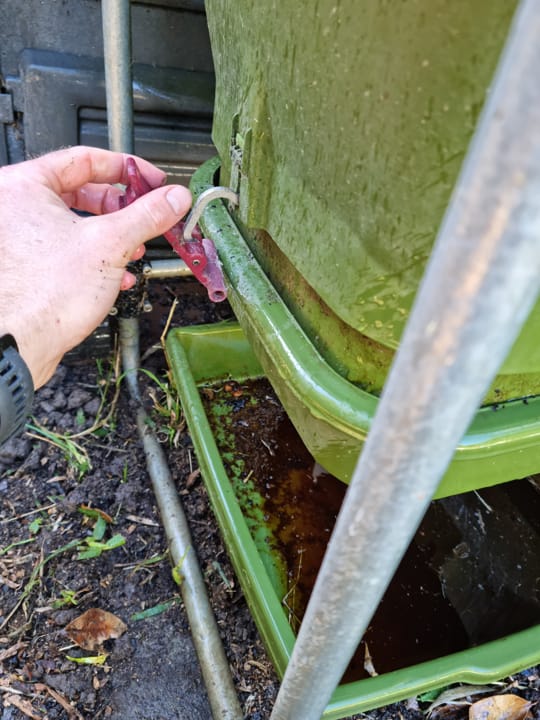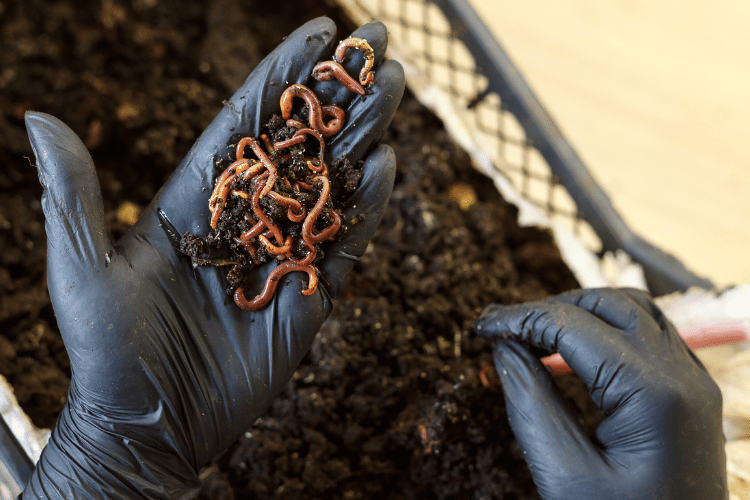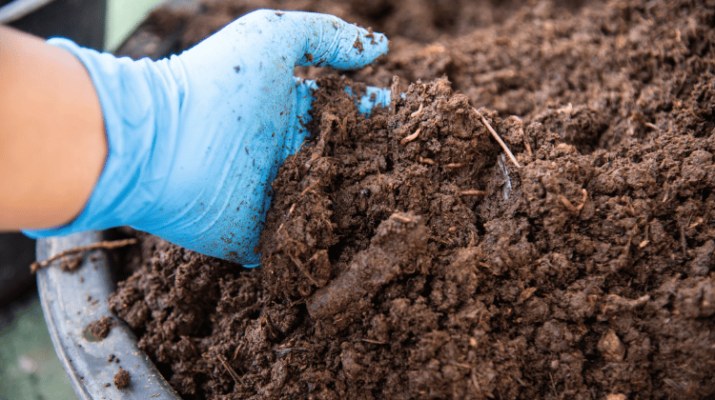If you’re into vermicomposting, you’ve probably heard of the efficient Hungry Bin worm farm. This farm is one of the most unique composts out there due to its design and capacity.
Hungry Bin produces high-quality castings and filtered liquid that your plants will surely thank you for. That’s not all. Its design keeps vermin away and the odor inside!
Do you want to find out more? Keep reading our Hungry Bin worm farm review to know all about the product and whether it’s right for you. Let’s dive in!

What Is Hungry Bin Worm Farm?
Hungry Bin worm farm is an innovative worm composting system based in New Zealand. The company started with a simple goal in mind, which is to create an efficient solution to compost large amounts of food waste. Spoiler alert, they did it!
The worm farm is an excellent, simple method to manage organic waste. More importantly, it has a revolutionary design that allows for adequate composting.
You don’t need to compost a small amount at a time, nor do you have to tuck your compost bin at the far side of your garden. In contrast, Hungry Bin is a large farm that’s odorless and easy to move.
How Does Hungry Bin Worm Farm Work?
Vermicomposting relies on worms to convert all kinds of organic waste into nutrient-rich liquid and worm castings. Both of these by-products are exceptional fertilizers.
It’s no secret that worms can perform better under certain living conditions. After all, you can’t just give worms food waste and expect them to start composting!
That’s where worm farms come in handy. They create an ideal environment for worms, separating the food from the castings.
The farm’s bedding is made of materials that support the worms’ growth and the drainage of castings and liquid. Usually, the bedding might consist of the following:
- Compost
- Soil
- Potting mix
- Shredded paper
- Dead leaves
- Coconut fiber
The compost worms can reproduce and eat away at the waste, producing fertilizer. However, you should pay attention to the type of food you provide your worms with.
While you want to reduce food waste as much as possible, compost worms won’t eat everything. They can eat yard waste, animal manure, shredded paper, and sawdust, but completely avoid other foods.
You shouldn’t feed your compost worms the following:
- Spicy food, onions, and garlic
- Processed wheat products
- Fats and oils
- Citrus and acidic fruit

Pros of Hungry Bin Worm Farm
If you’re worried about your carbon footprint, want to provide high-quality fertilizers for your plants, or looking for an environmentally-friendly way to get rid of food waste, you should definitely consider this worm farm.

Hungry Bin worm farm is one of the highest-rated worm composts for plenty of good reasons, including:
Capacity
The Hungry Bin worm farm has a gigantic capacity compared to its size. It can hold up to 12,000 compost worms. This hefty amount of worms can compost the average food waste of a family of four every day!
You won’t have to buy thousands of worms, though. Instead, Hungry Bin can supply you with 2,000 works to start. Then, the worm population will increase to match the food supply.
Your bin won’t become overpopulated as long as you regulate the type and amount of food you give the worms.
Simply put, your Hungry Bin worm farm can compost up to four pounds, or two kilograms, of food waste per day. This will supply you with a pint, or half a liter, of worm liquid daily!
Collecting
Removing the worm castings from compost bins might be the trickiest part of keeping worm farms. Yet, this isn’t the case with Hungry Pin.
The worm castings are automatically collected at the bottom of the bin due to the bin’s innovative, conical design.
The fresh castings push old castings down. Then, you can remove old castings and use them as a superfood for your plants.
Ideally, you should clean the old castings once every two to six months. Otherwise, you risk the bin material falling out as the castings haven’t been compressed enough.
As for the fertilizer, the liquid drains through the bin and passes through a filter. You can collect the worm liquid every day from the drip tray.
Since the liquid is filtered, it’s safe for your plants and acts as an excellent fertilizer. That said, you must dilute the worm liquid before using it. Hungry Bin recommends a dilution ratio of one part worm liquid to ten parts water.

Convenience
The major issues when it comes to composting are pests and smell. Luckily, Hungry Bin prevents both. The worm farm has a tight seal that keeps any vermin away. Still, you might need to keep your pets away from the drip tray, as they might try to drink the liquid!
The bin is significantly clean. It doesn’t produce any foul smell. The castings and liquid are both odorless. Additionally, the worms take care of all food scraps before it rots, granted you don’t overfeed them.
Hungry Bin relies on special compost worms, not earthworms. These worms live on top of the soil. So, you can place your food waste on top, and they’ll do the work for you.
You don’t even need to supply your worms with food every day. If you’re going on vacation, your compost worms will survive for up to two weeks on paper, leaves, or other materials.
Ease-of-Use
If you haven’t used a compost bin before, don’t worry! Hungry Bin worm farm is incredibly easy to assemble and use.
Since there are plenty of parts to assemble, the huge worm farm seems intimidating at first. However, you can build it in a matter of minutes thanks to the simple assembly instructions.
The farm’s body is also significantly secure. It comes with multiple latches and a tight-fitting seal. This means you won’t have to worry about the entire farm falling.
The best part has to be the wheels! Hungry Bin is a heavy worm farm, so transporting it should be tricky. Yet, due to the zinc-plated legs and wheels, you can easily move it anywhere.
Cons of Hungry Bin Worm Farm

Hungry Bin is undoubtedly a great composting option. Still, you need to be aware of the following aspects before purchasing the large compost bin:
Design
The design of Hungry Bin is pretty innovative. At first glance, you might mistake the compost bin for a trash can on wheels!
While some people might adore the one-of-a-kind design, it looks odd in most places. The Hungry Bin worm farm also looks bulky. So, if you’re into minimalism, this compost bin might not suit you.
Furthermore, the Hungry Bin worm farm has a vast surface area. Though the vast space is perfect for the compost worms, you’ll need plenty of outdoor space for the bin.
Accordingly, if you’re just starting out with compost, the worm farm might be more than you can handle.
The dimensions of the farm are 950 mm x 650 mm x 600 mm. It weighs 26.4 lbs (12 kg) empty and a whopping 209 lbs (95 kg) when full. Naturally, you must also have enough space to keep the farm-on-wheels. Ideally, the worm farm is best kept outdoors.
Price
The Hungry Bin is one of the pricier worm farm options on the market. That said, this farm will last you a lifetime. The worm farm kit also includes everything you’ll need to start composting, including live worms!
If you’re a beginner, dropping hundreds of dollars for the worm farm is farfetched, especially if you haven’t dealt with worms before.
For this reason, you might want to start with a simpler worm farm until you get the hang of worm composting. On the other hand, this pricey worm farm is a great option for seasoned green thumbs. In fact, it might save you a lot of time and effort in the long run.
Frequently Asked Questions
How often should I feed my Hungry Bin worm farm?
Hungry Bin worm farm has a large capacity. That said, you shouldn’t add any food waste just to get rid of it. Instead, feed your worms only when they eat the old waste.
If you can, you should measure the food in the bin. Feed the worms an inch of food daily, or about 2.5 cm. The food in the compost shouldn’t exceed two inches (5 cm).
What worms are used in Hungry Bin worm farm?
Typically, worm farms use specific compost worms that are perfectly suited to eat food waste.
These can be tiger worms (Eisenia foetida), red worms (Lumbricus rubellus), or Indian blue worms (Perionyx excavatus).
Conclusion
Vermicomposting is an excellent way to reduce your carbon footprint while giving your plants high-quality fertilizer. Luckily, our Hungry Bin worm farm review proves that anyone can compost!
Hungry Bin worm farm is simple to assemble and use. The kit comes with 500 worms. Once they reproduce to full capacity, they can compost up to four pounds of waste daily.
Collecting the liquid compost and castings couldn’t be simpler, since the bin is self-draining. The best part is that there’s absolutely no odor. That said, if you’re only starting composting, you might want to consider a smaller, less expensive farm.

